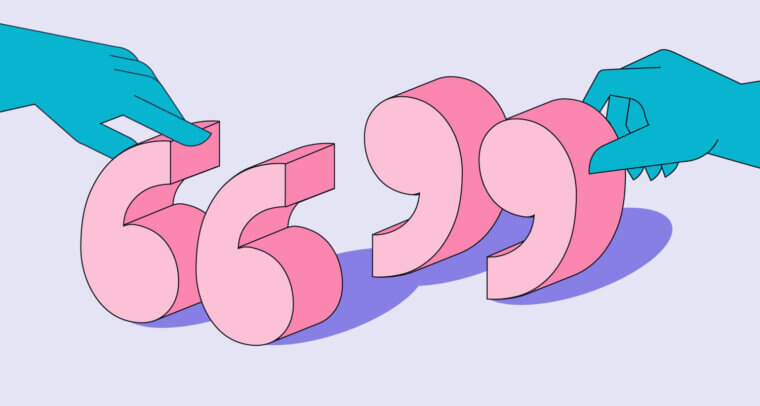
Plagiarism is the act of passing off someone else’s work as your own. That’s the most basic definition—there’s actually a lot more nuance to it, and you might be surprised to learn just how many different kinds of plagiarism exist.
As a student, your school likely has a plagiarism policy. Individual instructors might also have their own policies for dealing with instances of plagiarism. Plagiarism is a serious offense that can potentially result in getting no credit for the plagiarized assignment, being put on academic probation, or even being suspended or expelled from your school or program. The most effective way to avoid being accused of (or inadvertently committing) plagiarism is to understand everything that it is and how to properly credit every author whose work you cite in your own writing.
What is plagiarism, and why should it be avoided?
As we said above, plagiarism occurs when one writer attempts to pass off another writer’s work as their own. But that’s not all plagiarism is. Plagiarism also occurs when a writer references another’s work in their own writing and doesn’t properly credit the author whose work they referenced. It’s even possible for a writer to plagiarize their own work.
Plagiarism should be avoided for a variety of reasons. For one, it’s dishonest. Put simply, presenting another writer’s work as your own is lying.
Another reason to avoid plagiarism is that you don’t learn anything by plagiarizing another’s work. When your professor assigns an essay, they expect an honest effort from you to engage with the topic you’re covering, apply critical thinking skills, and demonstrate your ability to effectively develop, present, and defend your position. An original essay, flaws and all, shows your professor how you’re progressing in their class and any areas where you might need some extra support.
It’s also disrespectful to the original author. Writing is work, and it can be very challenging work at times. Claiming somebody else’s work as your own strips them of the recognition they deserve for the effort they put into creating it and gives yourself undue credit.
Keep in mind that although this blog post focuses on plagiarism in writing, it’s possible to plagiarize any kind of creative or academic work. Copying another artist’s work is a form of plagiarism, taking credit for another scientist’s research is plagiarism, and copying another app’s code and building your own with it without recognizing the original programmer is plagiarism. Basically, any act of presenting another person’s work as your own is an act of plagiarism. When you profit from an act of plagiarism, it’s known as intellectual property theft. Intellectual property theft is a criminal offense.
7 common types of plagiarism
Plagiarism comes in many forms. These seven types of plagiarism are the most common:
1 Complete plagiarism
This overt type of plagiarism occurs when a writer submits someone else’s work in their own name. Paying somebody to write a paper for you, then handing that paper in with your name on it, is an act of complete plagiarism—as is stealing or “borrowing” someone’s work and submitting it as your own.
An example of complete plagiarism is submitting a research paper for English class that your older sister wrote and submitted when she took the class five years ago.
2 Direct plagiarism
Direct plagiarism is similar to complete plagiarism in that it, too, is the overt passing-off of another writer’s words as your own. The difference between the two is how much of the paper is plagiarized. With complete plagiarism, it’s the entire paper. With direct plagiarism, specific sections or paragraphs are included without crediting (or even acknowledging) the author.
An example of direct plagiarism is dropping a line or two from your source directly into your work without quoting or citing the source.
3 Paraphrasing plagiarism
Paraphrasing plagiarism is what happens when a writer reuses another’s work and changes a few words or phrases. It’s a common type of plagiarism, and many students don’t even realize it’s a form of plagiarism. But if you’re presenting someone else’s original idea in your writing without crediting them, even if you’re presenting it in your own words, it’s plagiarism.
4 Self-plagiarism
You might be surprised to find out that you can plagiarize yourself.
How? After all, your original thoughts are your own to use as you please . . . right?
Yes, but with a caveat. Let’s say you wrote an essay about the pros and cons of changing your city’s zoning laws two years ago, and now you’re writing a research paper about how adopting certain zoning laws has impacted other cities in the past decade. Reusing content from your essay in your research paper would be an act of self-plagiarism. You can absolutely use the same sources and if you cite them properly, you don’t have to worry about being accused of plagiarism.
Self-plagiarism can be an issue if you write professionally. When you’re commissioned to write for a client, the client owns that work. Reusing your own words for subsequent clients is plagiarizing your own work and can damage your professional reputation (as well as make your clients look bad).
5 Patchwork plagiarism
Also known as mosaic plagiarism, patchwork plagiarism refers to instances where plagiarized work is interwoven with the writer’s original work. This kind of plagiarism can be subtle and easy to miss, and it may happen in conjunction with direct plagiarism.
An example of patchwork plagiarism is taking a clause from a source and embedding it in a sentence of your own.
6 Source-based plagiarism
Source-based plagiarism can be a tricky one to understand. With this kind of plagiarism, the writer might cite their sources correctly but present the sources in a misleading way.
For example, the writer might reference a secondary source in their work but only credit the primary source from which that secondary source is derived. Other examples include citing an incorrect source and even making up sources.
7 Accidental plagiarism
Accidental plagiarism is perhaps the most common type of plagiarism because it happens when the writer doesn’t realize they are plagiarizing another’s work. Accidental plagiarism includes the following:
- Forgetting to cite your sources in your work
- Not citing your sources correctly
- Failing to put quotes around cited material
Even accidental plagiarism is subject to consequences, such as failing your assignment.
Consequences of plagiarism
Plagiarism can have serious consequences. Depending on the nature of the plagiarism and the university or instructor’s policy, here are some possible consequences:
- Academic probation
- Failure of the assignment
- Failure of the course
- Suspension
- Dismissal from the program or the institution
Additionally, you can seriously damage your academic and/or professional reputation.
Plagiarism isn’t limited to academic writing. It’s also possible to plagiarize creative writing and online content.
While nobody owns an idea, plagiarism in fiction typically means using another author’s characters, setting, or specific plot and/or concepts without their permission. The reason fanfiction typically isn’t considered plagiarism is that the author acknowledges that their work is based on an existing published piece.
When it comes to online content like blog posts and infographics, you can avoid plagiarism by simply asking the original creator for permission to repost their content and if they agree, making sure you credit them.
How to avoid unintentional plagiarism
Before you write your works cited page, review the correct citation format for the style guide you’re working with. If you’re not sure which style guide to use, ask your instructor.
Another way to avoid unintentional plagiarism is to be as thorough as possible with your citations. Although you don’t need to cite facts that are common knowledge, err on the side of caution and cite any you’re unsure about. Remember, something that’s common knowledge in your field may not be common to people outside it.
You can also check your work with an online plagiarism detector, like the one available through Grammarly Premium, before submitting it to your instructor. Learning how to work with academic sources and avoid plagiarism is one of the most valuable writing skills you’ll learn in your college career.
Types of plagiarism FAQs
What is plagiarism?
Plagiarism is the act of attempting to pass off another person’s work as your own.
Can plagiarism be accidental?
Yes. Failing to quote or cite sources properly is considered plagiarism, even if the writer didn’t mean to plagiarize.
What’s the difference between paraphrasing and plagiarizing?
Paraphrasing is repeating or rewriting someone else’s words or ideas, usually changing some of the words or presenting the information in a different sequence to make the message clearer. Paraphrasing isn’t plagiarizing when you credit the idea’s original creator.
What are the common types of plagiarism?
Seven common types of plagiarism include:
- Complete plagiarism
- Direct plagiarism
- Paraphrasing plagiarism
- Self-plagiarism
- Patchwork plagiarism
- Source-based plagiarism
- Accidental plagiarism
How is plagiarism detected?
Plagiarism is almost always detected using software. A few popular plagiarism checkers include Turnitin and Grammarly’s plagiarism checker. In the past, plagiarism was more difficult to catch, and being able to catch it often hinged on an instructor’s familiarity with the student’s voice and academic acuity.
Write confidently in your own words
No matter what you’re writing, it can be easy to overlook spelling and grammatical mistakes when you’re editing your work. It can also be easy to shift your writing’s tone without realizing it. Grammarly can help. Before you click “submit,” have Grammarly give your writing a once-over and take a look at its correctness, clarity, engagement, and delivery suggestions.

